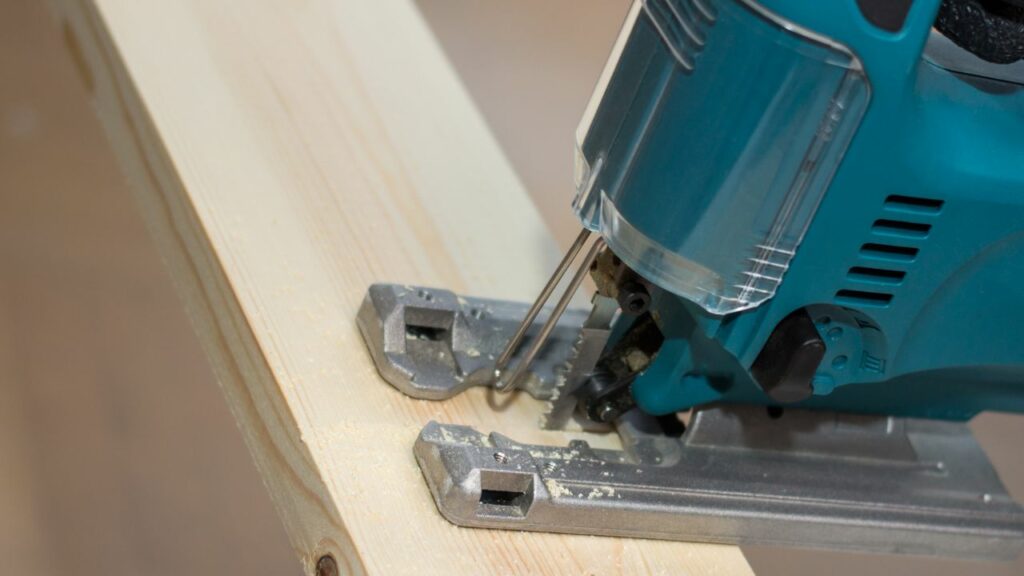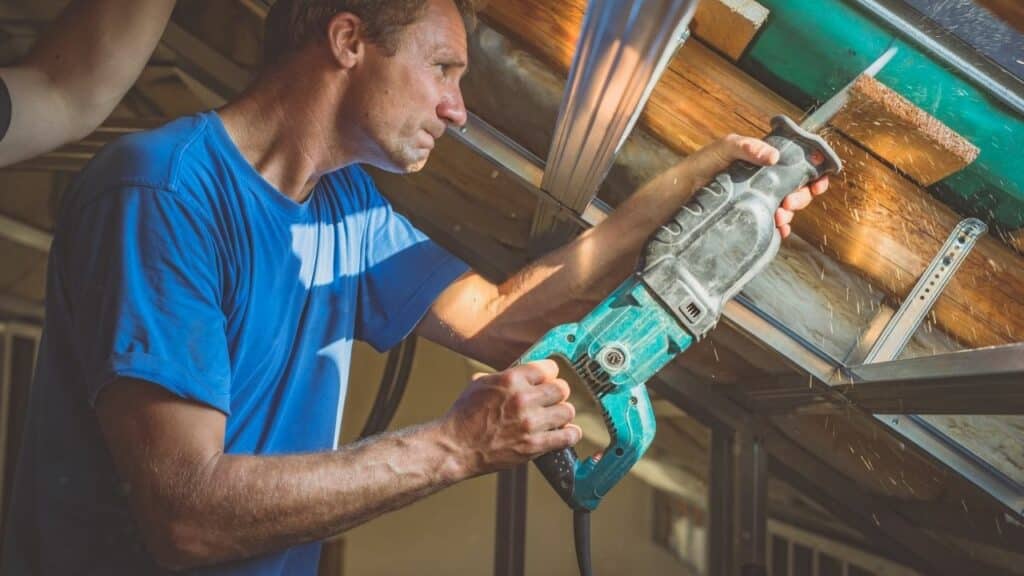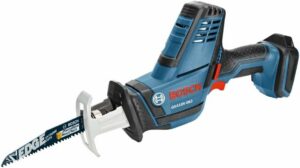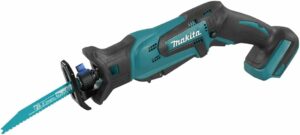Last Updated on October 17, 2023 by Pro Handyman Australia – Editorial Team
Starting a DIY project or renovation task comes with the pivotal decision of choosing the right tool. If you’re trying to quickly discern the primary differences between a reciprocating saw and a jigsaw, here’s your straightforward answer: reciprocating saws are all about power and are ideal for heavy-duty, aggressive cuts, often used in demolition and remodeling. In contrast, jigsaws specialize in precision, allowing for detailed and curved cuts, making them perfect for woodworking or detailed craft projects. Below, we delve into the unique aspects of each to aid you further in making an informed choice.
Reciprocating Saw: Power and Versatility

The reciprocating saw is your go-to powerhouse for heavy-duty tasks, characterized by its robust blade performing rapid back-and-forth strokes. This tool’s aggressive cutting ability is often harnessed in construction and demolition, making quick work of cutting through wood, metal, and even plastic. Key attributes that enhance its performance include:
- Orbital action that intensifies the cutting motion, ideal for demanding tasks.
- Variable speed settings, allowing users to tailor the tool’s operation to different materials.
- An adjustable shoe that stabilizes the saw during use, enhancing control and safety.
- Quick and hassle-free blade changes, a boon for projects requiring versatility.
- Built-in vibration reduction features, essential for extended use, reducing user fatigue.
- Sturdy construction, ensuring the tool’s resilience in harsh working conditions.
Understanding these features will help you recognize the reciprocating saw’s capabilities and why it’s often the preferred tool for heavy-duty, less detailed work.
Jigsaw: Precision and Control

If intricate, detailed work is your priority, the jigsaw stands out. Unlike its more aggressive counterpart, the jigsaw uses a smaller blade to achieve precision, perfect for creating curved or patterned cuts. Its functionality extends beyond wood, handling materials like metal, laminate, and more with ease. Essential features include:
- The blade’s quality and variety, influencing the finesse of each cut.
- The stroke length and rate, impacting the speed and efficiency of the cutting process.
- An often lighter design, offering better maneuverability for detailed work.
- Additional conveniences such as LED lights, improving accuracy by increasing visibility on the workpiece.
The jigsaw, with its emphasis on precision and control, is ideally suited for tasks requiring detailed craftsmanship, such as creating intricate patterns or finishing touches on woodworking projects.
In-Depth Comparison: Features and Specifications
The Cord Dilemma: Corded vs. Cordless
Your project’s nature and duration significantly influence whether a corded or cordless saw is more suitable. Cordless saws offer the advantage of mobility, allowing you to maneuver freely across various work areas. However, their battery dependency restricts operational longevity. Conversely, corded models are optimal for extended projects within a consistent workspace, where they provide uninterrupted power supply through direct electrical access.
The classic dilemma between corded and cordless models hinges on your project’s scope and setting. While cordless jigsaws provide the liberty to move unhindered, corded variants promise uninterrupted operation, essential for extensive tasks.
Evaluating Motor Efficiency and Power
Understanding a saw’s power is integral to matching it with the demands of your project. A saw’s amperage signifies its power, with higher amps indicating greater strength. However, a balance between power and budget is essential, as higher-amp saws come at a steeper price. In the realm of cordless saws, voltage is a critical factor. Commonly, you will encounter 18V and 20V models. A 20V indicator signifies the initial output, which equalizes to 18V during operation.
In terms of power, a jigsaw’s amperage signals its capability. A high-amperage tool offers robust performance, equipping you to handle more rigorous tasks effortlessly. It’s an investment in smoother, more efficient cutting experiences.
Importance of Variable Speed Control
Speed regulation is a standard feature in reciprocating saws, allowing for finesse and adaptability during cuts. The presence of triggers or dials for speed adjustment provides you with control, catering to your comfort and task requirements. Choosing between these depends on personal preference and the specific demands of your project, ensuring a tailored cutting experience.
As you prepare for your renovation journey or DIY endeavor, comprehending the nuances of these essential saws will empower you to make informed decisions, optimizing productivity and craftsmanship on your project.
Invest in a jigsaw that allows for variable speed control. Different cutting scenarios necessitate different speeds; having the flexibility to adjust the cutting speed ensures cleaner, more precise cuts, and accommodates a broader range of materials.
Effortless Blade Replacement
During your ventures with a reciprocating saw, blade replacement is inevitable. Blades may wear down or a different material might demand a specific type. Opt for saws featuring tool-less blade changes, facilitating a swift, safe, and efficient transition that keeps your project on track.
Understanding Stroke Dynamics
Reciprocating saws operate within a typical range of 2700 to 3000 Strokes Per Minute (SPM). Ideal operational efficiency often sits around a sweet spot, such as 2900 SPM. Additionally, stroke lengths in these saws commonly range from 1 to 1 ¼ inches, with 1 ⅛ inches being a standard measurement, balancing speed and precision.
Managing Vibration for Comfort
Given the inherent motion of reciprocating saws, they can produce significant vibration, potentially affecting your control and comfort. Prioritize models featuring vibration control or anti-vibe technology. This enhancement makes prolonged cutting tasks more manageable and less taxing on your hands.
Exploring Orbital Action and Bevel Cuts
The conventional jigsaw excels in an up-and-down cutting motion. However, orbital action jigsaws introduce a forward and backward movement on the upswing, enabling more aggressive cutting. This subtle yet impactful alteration can significantly influence the saw’s performance on various materials.
Superior jigsaws feature adjustable shoes that facilitate beveled cuts, with pre-set stops at common angles like 22.5, 45, or even 60 degrees. It’s prudent to avoid aluminum-stamped shoes, favoring those crafted from cast steel for enhanced durability and performance.
Modern Conveniences: Dust Ports and Illumination
Recent jigsaw models have embraced features like dust ports or bags and LED lights or lasers. These features, while not essential, significantly enhance visibility and cleanliness in your workspace, fostering a more efficient cutting process.
Comparative Analysis: Pros and Cons
Analyzing Reciprocating Saws: Advantages and Drawbacks
Reciprocating saws boast several benefits, including their portability, variable speeds, versatility, convenience, and improved stroke lengths. However, they fall short in precision cutting and pose safety risks due to their heavy-duty nature, demanding careful handling to prevent hazardous situations.
Deciphering Jigsaws: Strengths and Limitations
Jigsaws present numerous advantages such as ease of handling, powerful motors, keyless blade changes, multiple orbital settings, and optimal cutting capacities. Nonetheless, they have their shortcomings, including limited durability, the delicateness of blades, and excessive vibration in lower-end models. These factors necessitate thorough consideration before investment.
Practical Applications and Limitations
Reciprocating Saw and Jigsaw Interchangeability
One might wonder if a reciprocating saw can function as a jigsaw. Technically, it is possible because a jigsaw falls under the reciprocating saw category. However, reciprocating saws lack the finesse jigsaws possess in detailed work. So, while you can use a reciprocating saw for broader strokes, it doesn’t replace a jigsaw’s precision in more intricate cuts.

Versatility of Reciprocating Saws
Reciprocating saws boast versatility in their applications. They effortlessly cut through various materials, including but not limited to wood, most metals, lumber, plywood, and even wood embedded with nails. This wide range of functionality makes them indispensable in construction and renovation environments.
Jigsaw Versus Ordinary Saw: Precision Against Force
When comparing a jigsaw to a standard saw, the key differentiation lies in the versatility and precision of the cut. While an ordinary saw efficiently handles basic woodcutting, a jigsaw goes beyond, offering precision and the ability to navigate through a plethora of materials with a finesse that a regular saw simply cannot match.
Jigsaws and Tree Branches: A Cautionary Tale
Using a jigsaw to cut tree branches is feasible but not advisable. The process requires a slow, cautious approach while ensuring the branch is stable. Additionally, using the highest quality blades is non-negotiable for this task, as substandard blades can compromise the cut and your safety.
User Experience: Real-Life Performance of Reciprocating Saws vs Jigsaws
When it comes to hands-on experience, nothing speaks louder than the voices of those who have wielded the tools themselves. In the realm of cutting tools, reciprocating saws and jigsaws serve distinct purposes, a fact well-reflected in the experiences shared by users across various projects.

Take, for instance, the Bosch GSA18V-083B, a popular reciprocating saw known for its raw power. Freelance carpenter, James, recalls his experience: “I was working on a demolition project and the Bosch GSA18V-083B was a lifesaver. It tore through old framing lumber like it was butter. The variable speed trigger was exceptionally responsive, allowing me to maneuver through materials with different densities without overcutting.”

On the other hand, the jigsaw BLACK+DECKER 400W received high praise in the realm of intricate cutting. Sarah, an avid DIY enthusiast, shared, “I used the BLACK+DECKER 400W for creating custom shapes on my hardwood project. The cuts were incredibly clean, and the saw’s orbital settings made it possible to adjust my approach based on the cut’s complexity. It’s lightweight, and the dust blower ensured I always had a clear line of sight.”
These firsthand accounts underscore the importance of selecting the right tool for the job, highlighting that while the robustness of a reciprocating saw like Bosch GSA18V-083B is unparalleled for heavy-duty tasks, the finesse and precision offered by a jigsaw like BLACK+DECKER 400W stand out for detailed, intricate work.
In-Depth Comparisons: Analyzing Reciprocating Saws and Jigsaws
In the world of power tools, understanding the nuances between different models can be the key to selecting the right one for your needs. Let’s delve into an in-depth comparison of two leading models: the Makita DJR183Z reciprocating saw and the Bosch 530W jigsaw.
| Feature | Makita DJR183Z (Reciprocating Saw) | Bosch 530W (Jigsaw) |
|---|---|---|
| Power | 10 Amps | 6 Amps |
| Speed (No Load SPM) | 0-2,800 | 800-3,000 |
| Stroke Length | 1.125 inches | 1 inch |
| Keyless Blade Change | Yes | Yes |
| Adjustable Shoe | No | Yes |
| Price | $159 | $129 |

The Makita DJR183Z reciprocating saw boasts a commanding 10-amp motor, ideal for demanding cuts and heavy materials. However, it comes at a higher price point and lacks the adjustable shoe feature, something that craftsmen find essential for angled cuts.

Conversely, the Bosch 530W jigsaw, while less powerful, offers greater control over the cut’s precision, with an adjustable shoe for bevel cuts and a competitive pricing point. Its range of speed provides the adaptability needed for various materials and cutting requirements.
Reciprocating Saw Versus Jigsaw: Making the Right Choice
In the debate between reciprocating saws and jigsaws, naming one as superior to the other is impractical. Each tool excels in specific scenarios. Jigsaws are the go-to for detailed, precise work, whereas reciprocating saws thrive in rugged conditions, cutting through robust materials. The choice hinges on the nature of your project. Assess the demands of your task and select the tool that most aligns with your project’s requirements.
Conclusion
In conclusion, both reciprocating saws and jigsaws hold significant places in the toolkit of any craftsman, hobbyist, or professional. Their unique strengths make them suited to different tasks, with jigsaws providing intricate detail and reciprocating saws offering powerful, less nuanced cuts. The decision on which to use should stem from a clear understanding of your project’s specifics. For those in Canberra Handyman Services, recognizing the distinct advantages and limitations of each tool can efficiently leverage their capabilities to enhance craftsmanship and achieve optimal results in various endeavors. This informed approach ensures that every project, whether it requires the finesse of a jigsaw or the robustness of a reciprocating saw, is executed with precision and skill.
